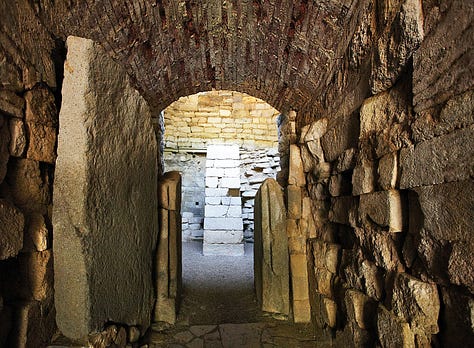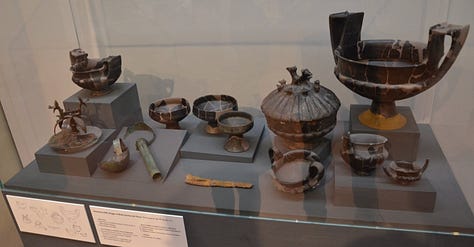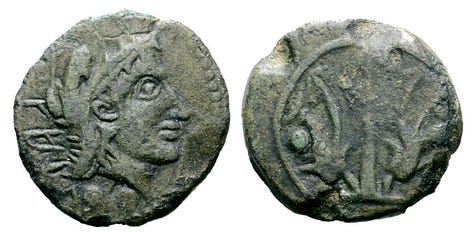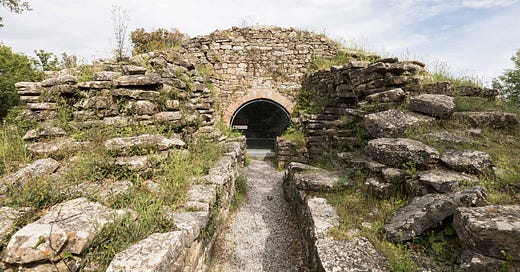Fresh Batch #67: The Etruscan City of Vetulonia
Complete Loss of Etruscan History, or Complete Destruction of It?
Vetulonia has the same problem as locations like Troy. It’s existence is only known through literature, not historical artifacts. Then, an archaeologist discovers it in the 18th century, just like Troy. I’m not claiming the sites aren’t authentic, or taking away from the amazing feat of excavating these areas. However, there’s no evidence there to prove the cities are as claimed. In fact, the opposite has turned out to be the case in so-called “Troy”, which is in Turkey, and the gold found there was not the Greek horde as claimed. It turned out to be Persian or some other Mesopotamian culture. We’ll get into the alleged Troy, but for now, I want to bring your attention to the masonry at Vetulonia.








There is nothing remarkable to indicate it is Etruscan. This masonry could be substituted at any period in history and be passed off as authentic to the time. However, there is an Etruscan wall there that is unmistakable.
The artifacts aren’t exactly revealing, and even if they were, there isn’t enough Etruscan script to prove that the site is as claimed. Etruscan pottery made it all over the world. Just because it showed up in one area doesn’t prove anything aside from its existence.









The bucchero pottery is present, and the bronzes they found are incredible, but is no one else suspicious of how they can draw the entire portion of the missing parts of that chest?





The Etruscans especially revered Nethuns at Vetulonia according to E. Macnamara (The Everyday Life of the Etruscans (1973), pp. 155f). This is Poseidon and Neptune, an aspect of the sun in spring, but also of the sea. This is significant to my work because it supports the link between the navigators and the Etruscans (who are likely Phoenicians), as well as their part in the ancient maritime empire that I suspect is being covered up. The only caveat is that the coins of Vetulonia with the anchors and dolphins, the monument from the time of Claudius (41-54 AD) at Caere displaying a personified Vetulonia with a steering wheel on her shoulder (which may link her to Britannia), etc., are a millennium after the peak of her prosperity.



However, their early links with Sardegna solidify my suspicion of their descent from Phoenician ancestors, if they aren’t the actual Phoenicians. This is demonstrated by the false-domed tombs that came to Populonia from Sardegna c. 800 BC, which are found in Vetulonia. Sardinian bronze model boats and animals were also found in Vetulonian tombs from the 7th century BC. According to Strabo (V, 2, 7, 124, 225), Sardinian ports such as Tharros have yielded many Etruscan products, which is why he called the inhabitants Tyrrhenians (Etruscans).
Finding the ports of Vetulonia is challenging because according to Cristofani, sea-level was one meter higher between 600 BC and 100 AD than it is now. This is out of my wheelhouse, but the coasts lines do appear to have been eroded by higher seas. Perhaps a landscape change like the collapse of an isthmus (such as the Strait of Gibraltar), or some other geological phenomenon caused this. Grant wrote (The Etruscans, pp. 184, 185), “In ancient times, however, when the sea-level was so much higher, this flat land, as we have seen, was an extensive lagoon named Lake Prilius. The lagoon was fed by the Bruna and Ombrone alike (just as Pisae’s lagoon, which has likewise disappeared, took the inflow of both the Arno and the Serchio)—or canals may have linked it to the two rivers. Lake Prilius was also open to the sea through deep and navigable entrances, apparently augmented by a man-made channel.
“Traces of the buildings that stood along the shores of the lagoon in ancient times can be seen today. They date from the third and second centuries BC, showing that Lake Prilius still existed at that time; and Cicero mentioned an island in the middle of its waters in 52 BC (In Defense of Milo, XXIV, 74). Indeed, maps of the Renaissance and even later times continue to depict this lagoon and its outlet to the sea, though by then, like other Etruscan sea lakes, it had become an almost landlocked, lethally malarial swamp.”
Grant made a great observation (Ib. p. 185), “Moreover, other hamlets on either side of the lagoon’s shores, though once again wholly landlocked today, have or had Italian names that are suggestive of earlier maritime activity—Casa Galera (boat-house), Porto a Colle (hillside port), Porto alle Cavalle (mares’ port), Piscara a Mare (sea-fishing). It seems likely, therefore, that Vetulonia had a whole series of adjacent harbour installations on Lake Prilius.”
This Etruscan art is so inspired by the world yet so unique that the only explanation for how many different influences there are in their artifacts (should they be authentic) is that they were a people of the world, a culture from Italy that became a maritime empire, reaching every port a vessel could travel to, which gave way to the advantage of its successors, the Romans. To see how I demonstrated this, read The Holy Sailors (click the image).
There will be much more to say about Vetulonia, so become a member to access the rest of the article.
Keep reading with a 7-day free trial
Subscribe to Ancient History, Mythology, & Epic Fantasy to keep reading this post and get 7 days of free access to the full post archives.






